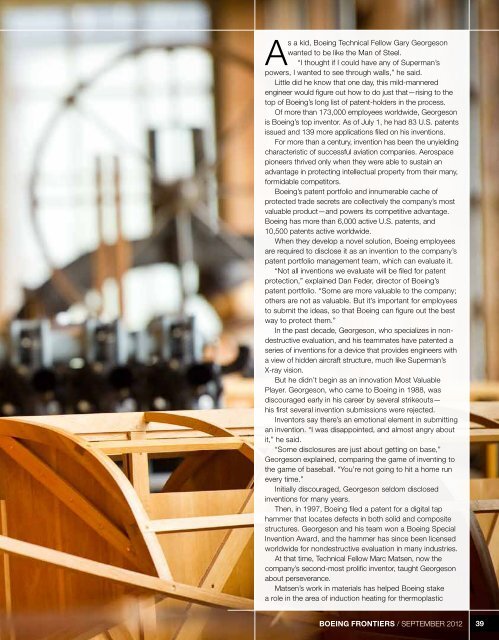Frontiers - Space-Library
Frontiers - Space-Library
Frontiers - Space-Library
You also want an ePaper? Increase the reach of your titles
YUMPU automatically turns print PDFs into web optimized ePapers that Google loves.
As a kid, Boeing Technical Fellow Gary Georgeson<br />
wanted to be like the Man of Steel.<br />
“I thought if I could have any of Superman’s<br />
powers, I wanted to see through walls,” he said.<br />
Little did he know that one day, this mild-mannered<br />
engineer would figure out how to do just that—rising to the<br />
top of Boeing’s long list of patent-holders in the process.<br />
Of more than 173,000 employees worldwide, Georgeson<br />
is Boeing’s top inventor. As of July 1, he had 83 U.S. patents<br />
issued and 139 more applications filed on his inventions.<br />
For more than a century, invention has been the unyielding<br />
characteristic of successful aviation companies. Aerospace<br />
pioneers thrived only when they were able to sustain an<br />
advantage in protecting intellectual property from their many,<br />
formidable competitors.<br />
Boeing’s patent portfolio and innumerable cache of<br />
protected trade secrets are collectively the company’s most<br />
valuable product—and powers its competitive advantage.<br />
Boeing has more than 6,000 active U.S. patents, and<br />
10,500 patents active worldwide.<br />
When they develop a novel solution, Boeing employees<br />
are required to disclose it as an invention to the company’s<br />
patent portfolio management team, which can evaluate it.<br />
“Not all inventions we evaluate will be filed for patent<br />
protection,” explained Dan Feder, director of Boeing’s<br />
patent portfolio. “Some are more valuable to the company;<br />
others are not as valuable. But it’s important for employees<br />
to submit the ideas, so that Boeing can figure out the best<br />
way to protect them.”<br />
In the past decade, Georgeson, who specializes in nondestructive<br />
evaluation, and his teammates have patented a<br />
series of inventions for a device that provides engineers with<br />
a view of hidden aircraft structure, much like Superman’s<br />
X-ray vision.<br />
But he didn’t begin as an innovation Most Valuable<br />
Player. Georgeson, who came to Boeing in 1988, was<br />
discouraged early in his career by several strikeouts—<br />
his first several invention submissions were rejected.<br />
Inventors say there’s an emotional element in submitting<br />
an invention. “I was disappointed, and almost angry about<br />
it,” he said.<br />
“Some disclosures are just about getting on base,”<br />
Georgeson explained, comparing the game of inventing to<br />
the game of baseball. “You’re not going to hit a home run<br />
every time.”<br />
Initially discouraged, Georgeson seldom disclosed<br />
inventions for many years.<br />
Then, in 1997, Boeing filed a patent for a digital tap<br />
hammer that locates defects in both solid and composite<br />
structures. Georgeson and his team won a Boeing Special<br />
Invention Award, and the hammer has since been licensed<br />
worldwide for nondestructive evaluation in many industries.<br />
At that time, Technical Fellow Marc Matsen, now the<br />
company’s second-most prolific inventor, taught Georgeson<br />
about perseverance.<br />
Matsen’s work in materials has helped Boeing stake<br />
a role in the area of induction heating for thermoplastic<br />
BOEING FRONTIERS / SEPTEMBER 2012<br />
39
















